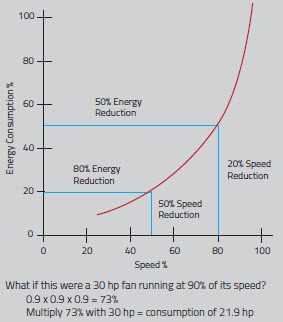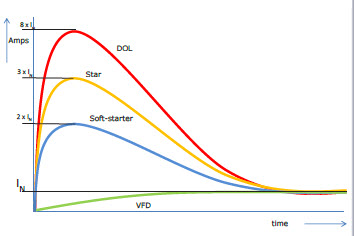How Regulating Speed Control Can Reduce Energy Costs
OVERVIEW
As manufacturers continue to struggle with increased operating costs and the pressure to reduce energy consumption, variable frequency drives (VFDs) are becoming a popular solution. In addition to the financial savings as a result of substantially lowering their use of electricity and overall energy consumption, other benefits can be realized as well. This white paper will focus on the many benefits of regulating the motor speed of weld fume control solutions utilizing VFDs.
WELD FUME CONTROL
Arc welding is safe when sufficient measures are taken to protect you from potential hazards. Welding fumes contain metal compounds that can pose health risks if not properly controlled, so it’s important to take the appropriate safety measures.
The Environmental Protection Agency (EPA) has requirements for the control of metal compound emissions. You must implement one or more of the following:
• Use a welding process with reduced fume generation capabilities
• Use welding process variations, which can reduce fume generation rates
• Use welding filler metals, shielding gases, carrier gases or other processes to reduce welding fume generation
• Optimize welding process variables to reduce the amount of welding
• Use a welding fume capture and control system
There is a variety of portable, stationary and engineered solutions for welding fume control. Since the operation of welding fume control equipment is affected by various factors, including proper use and positioning of the equipment, maintenance of the equipment and the specific welding procedure and application, contacting an expert is important to determine which solution is best for your application.
VARIABLE FREQUENCY DRIVES
Utilizing a weld fume control solution not only helps you meet safety and environmental requirements, but regulating the motor speed by utilizing a VFD can also substantially lower your use of electricity and overall energy consumption. A VFD is known by many names, such as an inverter, variable speed drive (VSD), frequency converter or AC drive. They all mean essentially the same thing; an electronic controller that adjusts the speed of an electric motor by modulating the power being delivered. The way to control the motor speed is to change the frequency of the alternating current (AC) power in the input. VFDs provide continuous control, allowing you to control the equipment’s output to match the operation’s needs.
POTENTIAL SAVINGS

Fan equipment for fume extraction is often used without speed control. Instead, flow is traditionally controlled by throttling with a valve or damper. When flow is controlled without regulating the motor speed, the fan motor continuously runs at full speed. Because weld fume control systems rarely require maximum flow, a system operating without speed control wastes significant amounts of energy, and consequently money, over most of its operating time.
In addition to speed control, VFDs provide soft starting gradually ramping up a motor’s operating speed at startup. This not only helps to maximize equipment life by reducing mechanical stress and voltage sags, but also reduces maintenance.
VFDs can improve the comfort level of employees by modulating the air flow throughout a facility, and by reducing the noise created by fans and pumps.
INTERACTION MOTOR VFD
In order to get the best performance out of each motor, you need to look for the motor specifications as they are affected by the different coil resistances as well as stator and rotor resistance. All these different parameters are only to be recognized by VFD with automatic motor adaption (AMA) ability. When the motor has been screened by the VFD, an ideal output voltage at each condition can be used to allow the motor to perform at its best efficiency, also known as Best Efficiency Point (BEP). Finding the BEP of a motor can provide a 3-4 percent efficiency increase and, thus, energy reduction.
After finding the BEP, you can look at the major savings when using a VFD. Note that the relation between the revolutions of the fan-impeller and consumed power is cubed.
When you employ the motor at full speed, the power consumption will be 100%, but if you run the motor at 80% of its rpm, the power will be valued to 0.8 x 0.8 x 0.8 = 51.2% of the power consumption. Refer to the graphic below.
IDEAL ENERGY CONSUMPTION AT VARYING SPEED
Next to savings when a fan is running, you also need to consider the inrush current motors induce when starting up. These inrush currents, which are much greater than the current draw of the motor, will require larger capacity cable sizes and fuses. A regular DOL start can introduce a start current up to eight times the current the motor uses when it is running in normal operation. However, this high current will be necessary only for a short time. We still need to take this in to account when selecting peripheral equipment used with the motor. In the picture below, the VFD does not exceed the nominal current when starting up (i.e. a SF 1200 fan, 7.5 kW motor at 380 V 50 Hz with IN of 14A can be fused with 3x16A fuses).
STARTING CURRENTS WITH DIFFERENT STARTING METHODS
GOVERNMENT REBATES AND INCENTIVES
In addition to the benefits listed above, cost savings can also be realized through government rebates and financial incentives, if available.
• Rebates — Utilize additional savings by taking advantage of government rebates on energy-efficient purchases. Visit www.energy.gov or www.energystar.gov for information about rebates in your location.
• Demand Response — Demand response initiatives help to reduce electricity demand at peak times to prevent strain on your system. For example, manufacturers can receive financial incentives for reducing their energy use on hot summer days.
• Benchmarking — ENERGY STAR is a U.S. Environmental Protection Agency voluntary program that helps businesses and individuals save money and protect our climate through superior energy efficiency. Visit www.energystar.gov for details.
CONCLUSION
Realizing the energy savings you expect starts with making sure the application runs a significant amount of time at a percentage which is significantly less than full output. When considering a VFD installation, take into account your operating schedule, as well as the type, size and age of equipment in your facility.




 Download White Paper
Download White Paper